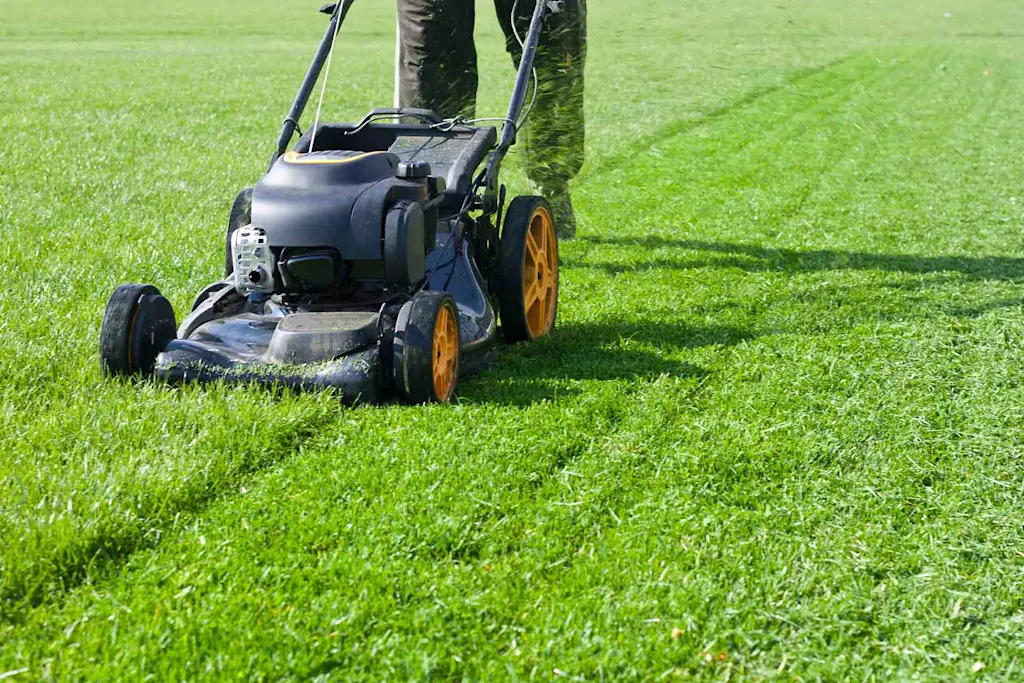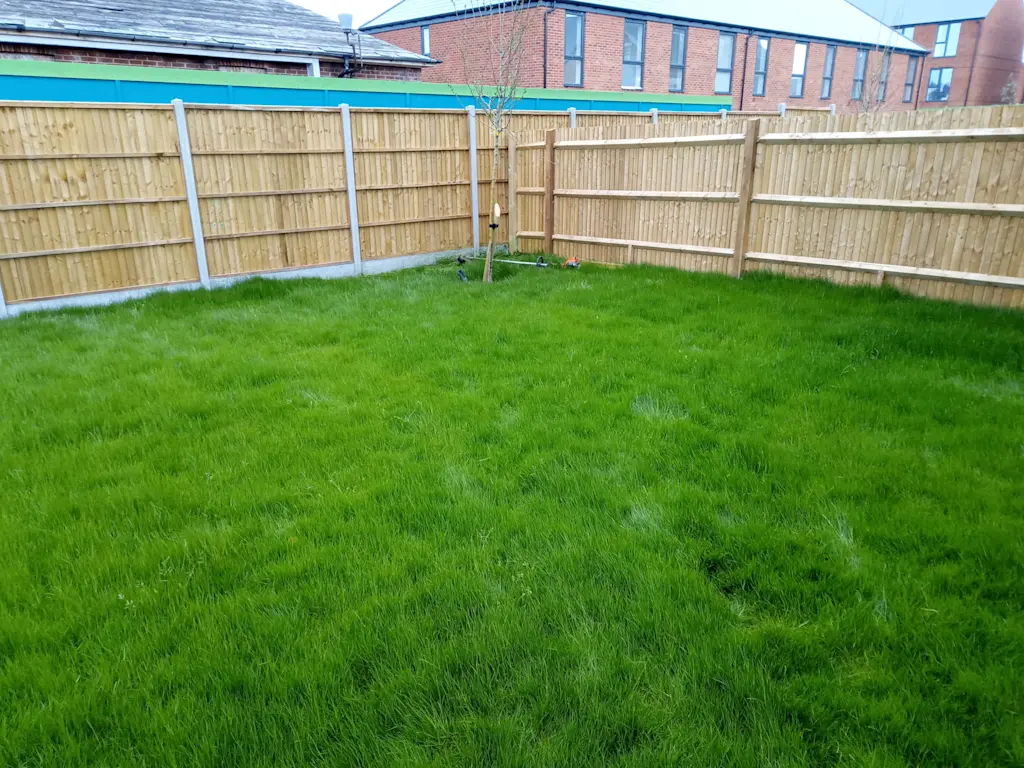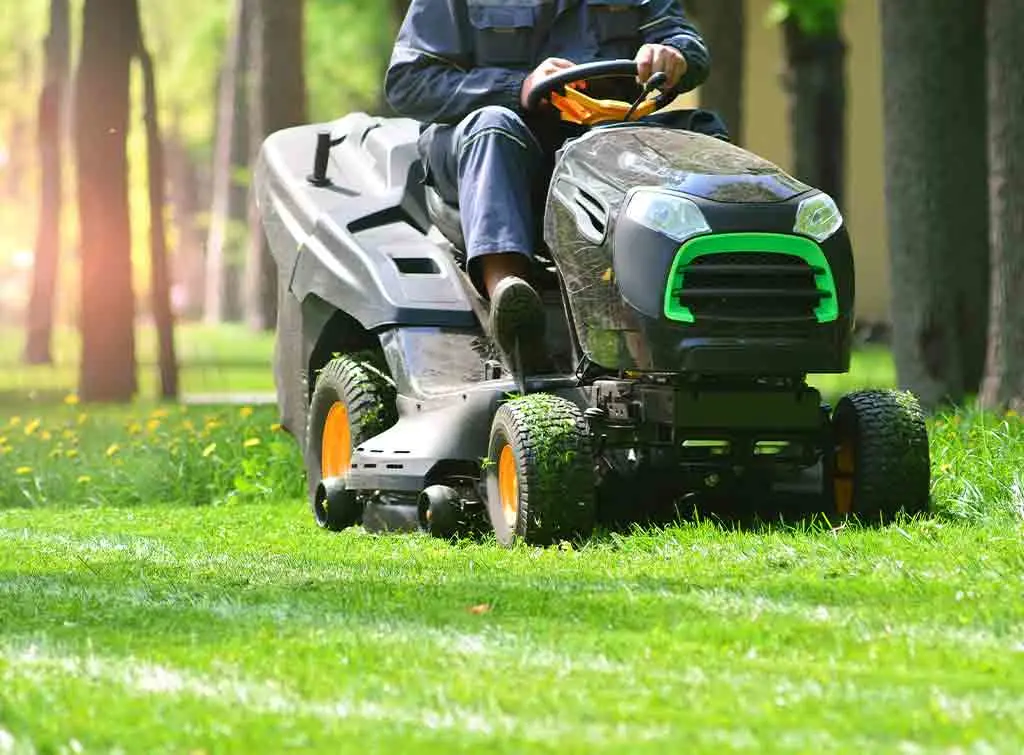Blog>How-To Guides>Your step-by-step on how to mow a lawn
Last updated: 30 May 2024
Your step-by-step on how to mow a lawn
Regular mowing will help your lawn stay neat, healthy and green. Follow our step by step guide to mowing like a pro!

Regular mowing is one of the best ways to promote healthy, hardwearing grass, and help stop weeds growing.
However, in spring and summer, the growth of your grass is fast. And for some homeowners or tenants, mowing the lawn can take a lot of time up, and is not fun.
If you'd prefer a professional to do the job, we've got you.
Enter your postcode in the box below and see who comes approved by us and recommended by people near you. Let's do this!
See the tradespeople we've checked and recommend for your job
Or, if you want to become a lawn mowing pro, keep reading to see how to mow a lawn properly!
How to mow a lawn
Whether you're a complete novice or a green-fingered pro, follow these simple steps to cut your grass properly.
1. Get the mower ready
If you haven't done so already, complete any mower maintenance, such as getting blades sharpened.
Or if you're old school with a petrol mower, you might need to top up its fuel.
2. Check the grass and soil conditions
Wait until the grass is dry (or frost-free) before mowing. Wet soil can get compacted and mower blades clogged with grass. You can also risk scalping the lawn
You may have to wait until any dew or frost has gone, or postpone until another day.
3. Clear the lawn
Move any furniture, sports equipment or outdoor toys off the grass. Don't forget to remove any debris like sticks and stones that could damage the mower blades.

4. Adjust the height of the mower blades
You'll need to adjust the height of your mower blades to suit different times of year and the style of lawn you want. This is usually a simple process of switching a dial or moving a lever.
Here's why it's crucial to adjust the height of mower blades:
Changing the cutting height will help keep your grass in good condition. A higher cut will create a wildflower-rich lawn
Don't be tempted to cut the grass too severely for the first mow of the year. Choose the highest blade setting to avoid choking the mower with clippings
If the grass is long, you may need to strim it first to reduce the overall height, then rake up the cut grass before going over with a mower
Aim to mow regularly, so you only need to remove a small amount of grass each time - and never take off more than one-third of the grass height at a time, as this can damage the vigour of the plant
As a general rule, keep grass at 13 - 25mm high in the summer and up to 40mm in spring and summer
With new lawns, wait until the grass is at least 5cm before mowing with the blades on the highest setting
In prolonged periods of hot, dry weather, leave the lawn a little longer, as this helps the grass retain moisture and provide a degree of shade for the soil
5. Mow around the edges of the lawn first
After the preparation is done, cut around the perimeter of your lawn —this will provide a border for the mower to turn around in.
This is especially important for irregular lawns as it will create a squared off mowing area.
6. Mow up and down in rows
Once you have done the perimeters, you should be left with a more regular square or rectangle so you can mow in rows.
Start at one edge and mow in a straight line. When you reach the end, turn the mower and come back down to mow your second row. Remember to overlap each row slightly so you don't miss bits.
If your lawn is irregularly shaped, start by mowing a line across the middle, then mow one side at a time.
7. Empty the clippings box or rake up grass clippings
Removing the clippings makes it easier to see your mowing progress and can also prevent some lawn fungal problems.
However, in very dry weather, leave clippings less than 1cm on the grass to help hold in moisture.
Top tip: Add grass clippings to your compost bin or heap to make your own sustainable garden compost that will benefit your soil and plants. Mix the clippings with layers of 'brown' woodier materials to stop it from becoming a slimy, smelly mess.
8. Tidy up the edges
For a really neat, professional finish, mow once more around the perimeter to tidy up any marks left by turning the mower.
Then, trim the edges of the lawn with long-handled edging shears.
Finally, collect and compost the clippings and trimmings as above. Job done!
Sound too much work?
Find a professional gardener near you.
See the tradespeople we've checked and recommend for your job
How to care for your mower

Keep mower blades clean and sharp to give you the best cut. If you are confident at sharpening rotary blades, be sure the mower is switched off and unplugged before going anywhere near the blades. It’s best to take cylinder mowers to a professional.
Give your mower a quick clean after regular use and a full clean and check before putting it away for winter. This will help minimise the need for repairs and keep your mower running well for years.
Fit a residual current device (RCD) to plug on electric mowers so the mower will stop if the cord is accidentally cut.
Store spare petrol safely - if you have a petrol mower, and take great care when refuelling.
Check regularly that the dead man's handle is functioning correctly so that the mower cuts out instantly if you let go.
Always wear robust footwear when mowing, even if the weather is warm.
Wear good eye protection when cutting rough grass or if gravel, stones, or other debris is in the lawn.
Wear full protective gear when strimming. Invest in steel toe cap boots, heavy-duty gloves and safety goggles. And before you start, always check areas of long grass for wildlife, such as hedgehogs.
How to get stripes in your lawn
If you love the look of a striped lawn, here's a few extra tips on how to cut grass and get some stripes. A mower with a rear roller is the best mower to stripe up any lawn.
Be the envy of the neighbourhood with a Wimbledon-style striped lawn:
Start by mowing around the edge of the lawn
For regular square and rectangular lawns, work from the left side, mowing up and down the lawn using the straight lawn edge as a guide to get a straight line
Irregularly shaped lawns are not as easy to stripe. But the best method is to line up the mower with a focal point to achieve the first straight line across the widest point. This can be your guide for subsequent stripes
At each turn, line up the mower so the next stripe slightly overlaps the last
Don't forget to empty the clippings box regularly - a full box can make the grass clumpy and spoil the finish
Corners may need cutting separately using lawn shears or a strimmer to get a really crisp edge
FAQs
How often should I mow?
Cut your lawn at least once a week in summer and once every two weeks during spring, autumn, and warm winters. Regular grass trimming encourages the roots to spread, which helps to fill gaps and block out weeds.
How can I avoid scalping?
Avoid mowing when the ground is too soft, as the wheels will likely sink in and cause scalping.
Don’t cut the lawn too close; take turns slowly with the mower. If your lawn is uneven or bumpy, it may be difficult to avoid scalping, so repairs should be considered to level out the lawn. Minor lumps and bumps can sometimes be addressed by aerating, overseeding, and brushing over topdressing.
Should I collect my grass clippings?
When you mow in spring and summer, leave the grass clippings on the lawn. As they decompose, they release up to 30 per cent of the lawn's required nutrients. Remove the clippings from the lawn at the beginning and end of the growing season when decomposition is slow.
Finding the time and energy to care for your lawn yourself can sometimes be a challenge. So, why not hire a professional near you to get your lawn in good nick?
We check and approve every member within our leading directory so you can be sure you’re getting the very best service.
See the tradespeople we've checked and recommend for your job
See the tradespeople we've checked and recommend for your job


